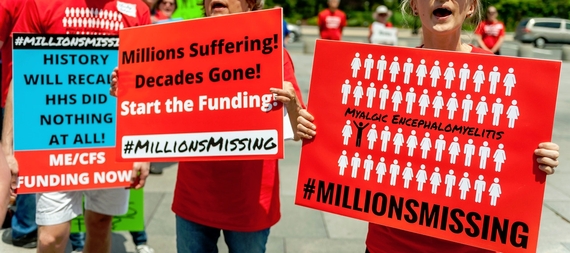This week, demonstrations occurred in 25 global cities world-wide to focus attention on a neglected, devastating disease -- Myalgic Encephalomyelitis (ME), an illness that also goes by the misleading name Chronic Fatigue Syndrome (CFS). At this event, the most powerful demonstrators were those who could not attend -- the bedridden and housebound patients.
The protest, named Millions Missing, has been organized by #MEAction, a patient/caregiver group. What millions are missing? Millions of people across the globe are missing the ability to lead normal lives, millions of dollars have been missing from what should be a government-funded research effort, and few of the more than 10 million doctors in the world have been properly educated as to the seriousness of the disease and how to diagnosis it.
Visual evidence of the impact of the disease were displays of thousands of shoes sent from patients too ill to attend. The symbolism reminds me of my school-age visit to a house-museum from Colonial Times in America, in which there was a heart-wrenching exhibit of children's shoes in a bedroom. Because of the childhood diseases untreatable in the 1700s, the parents had lost a dozen children. The largest pair of shoes each wore at the time he or she died was shown next to an empty bed.
As an ME/CFS researcher aware of the impact of this disease, I hope that anyone who passed by these demonstrations will be similarly affected to see the empty shoes of individuals who have lost their independent lives and must spend all their time in a darkened house or bedroom. Some of the shoes will be the last ones that severely ill patients were able to wear before becoming bedridden. Many patients are mostly housebound, too ill to go out except for occasional medical appointments. But such appointments do little good, as today's doctors cannot prescribe to most patients any remedies better than those available to a physician in Colonial Times. One drug, known as Ampligen, is able to help a sub-group of those struck down by ME/CFS, but the U.S. Food and Drug Administration (FDA) has failed to approve it.
Lacking any effective drugs, therapies that are useless or outright harmful, such as vigorous aerobic exercise, are sometimes recommended to ME/CFS victims by doctors who have been misled by a now-discredited, flawed study that erroneously claimed "recovery" through exercise therapy. Some treatments that have been recommended are as dangerous and ineffective as the blood-letting that may have killed George Washington,
In sharp contrast to the highly successful advocacy of the AIDS movement, the ME/CFS patient community has been strikingly ineffectual. AIDS exploded in frequency in the mid-1980s, as well documented in Randy Shilts' And The Band Played On. Before therapeutic drugs were available, HIV-positive individuals knew their time was limited, but still sometimes had years left, during which they could campaign for diagnostic tests, drug development, and preventative education. Indeed, they were so successful that during the last five years, the National Institutes of Health (NIH) spent $3 billion annually on HIV/AIDS research. As a result of effective advocacy, HIV infection has gone from a death sentence to a chronic disease treatable by a number of FDA-approved drugs.
Given the seriousness of the disease, why has the ME/CFS community been so unsuccessful relative to AIDS activists? Unlike those infected by HIV, ME/CFS victims often become disabled immediately after a flu-like illness, unable to mount protests, nor effectively support each other, nor lobby the government for research spending. Others spend years disabled before the diagnosis is even made. Because few of its victims have visible marks of the disease, even the parents and siblings of some sufferers don't understand the physical misery their family member is experiencing. Instead, some believe the unfortunately persistent myth that the disease is psychological.
All these factors have conspired to prevent effective advocacy. Many other diseases are receiving NIH funding at levels that are appropriate relative to seriousness and prevalence. But NIH has been providing only about $3 annually per disease victim for research on ME/CFS, which is estimated to affect several million Americans. Other diseases with comparable life-limiting effects receive hundreds or thousands of NIH research dollars per afflicted patient. Now so many people have fallen ill that renewed efforts by groups such as #MEaction Network, InvestinMe, Action for ME, ME Association and the Solve ME/CFS Initiative may finally be able persuade governments and the public that ME/CFS is a serious, biological disease that merits significant study and drug development. Dramatic demonstrations may be needed, such as the one by the young woman, carrying a sign saying "Now you can't ignore M.E.," who disrobed this past Tuesday in front of Whitehall in London amidst the display of patients' shoes.
Today's ME/CFS victims suffer not only from a life-limiting disease, but from neglect and misunderstanding by medical professionals and the public alike. Let's hope that the Millions Missing ME movement will finally convince everyone of the seriousness of this overlooked disease and garner the respect and support that will allow its victims to resume their lives.
